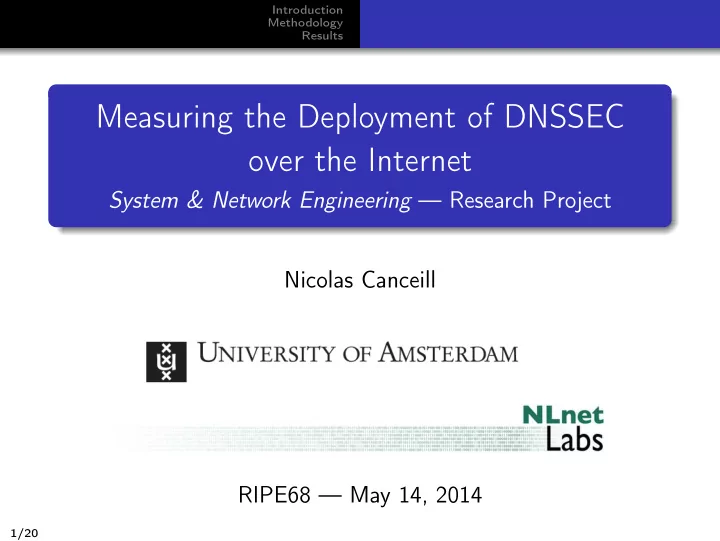

Introduction Methodology Results Measuring the Deployment of DNSSEC over the Internet System & Network Engineering — Research Project Nicolas Canceill RIPE68 — May 14, 2014 1/20
Introduction Methodology Results Introduction 1 Methodology 2 Results 3 2/20
Introduction Methodology Results What DNSSEC? DNS Domain Name System Essential foundation of the Internet Translates domain names into IP addresses Problem DNS is notoriously insecure Solution: DNSSEC Public key cryptography Signatures for al resources Hierarchical chain of trust 3/20
Introduction Methodology Results Introduction 1 Methodology 2 Results 3 4/20
Introduction Methodology Results History DNS Development 1983 DNS specification published 1984 First TLDs defined 1987 DNS becomes IETF standard DNSSEC Development 1997 DNSSEC specification published 1999 DNSSEC specification revised 2005 DNSSEC final revision DNSSEC Deployment 2010 Root level deployment 2011 Most TLDs signed 5/20
Introduction Methodology Results Research scope Research question What is the status of DNSSEC deployment over the Internet and how does it impact Internet users? Which DNS resolvers can be queried from clients? What methods can properly assess DNSSEC support? How does DNSSEC support influence user experience? 6/20
Introduction Methodology Results The Atlas network 5,000 active probes Worldwide — mostly Europe 7/20
Introduction Methodology Results Introduction 1 Methodology 2 Results 3 8/20
Introduction Methodology Results Setup Altlas probes: presence in client network Controlled nameserver with packet capture 9/20
Introduction Methodology Results Challenges Probes-resolvers IP address seen by the probe: 8.8.8.8 IP address seen by the nameserver: 74.125.18.209 Solution: pre-pend probe ID and use wildcards Probe 1234 requests 1234.example.com Resolving setup Probes with multiple resolvers Probes using forwarders Misconfigured resolvers 10/20
Introduction Methodology Results Limitations Atlas � = Internet Atlas Top10 Internet Top10 Country Probes Country Internet users (in 2012) United States 853 China 568,192,066 Germany 819 United States 254,295,536 Russia 724 India 151,598,994 United Kingdom 605 Japan 100,684,474 Netherlands 457 Brazil 99,357,737 France 397 Russia 75,926,004 Ukraine 364 Germany 68,296,919 Belgium 184 Nigeria 55,930,391 Italy 166 United Kingdom 54,861,245 Czech Republic 161 France 54,473,474 11/20
Introduction Methodology Results Process Steps 1 List all active probes 2 Start packet capture at the nameserver 3 Launch measurement on Atlas probes 4 Wait for measurement results 5 Stop packet capture 6 Repeat steps 2-5 until all active probes have been used Zones badlabel , badrrsigs , norrsigs secure insecure Software Python, atlas , dpkt nsd , ldns Wireshark 12/20
Introduction Methodology Results Introduction 1 Methodology 2 Results 3 13/20
Introduction Methodology Results Resolvers DO bit support Requests on TXT record from secure zone with DO bit set Probes Resolvers Setting DO bit Including RRSIG 4673 5139 4534 [88.23%] 3448 [67.09%] DS type support Requests on DS record from secure zone with DO bit set Probes Answers Authenticated 4553 4228 [92.73%] 1409 [30.41%] Resolvers Active Answers Authenticated 4586 4573 4252 [92.98%] 1374 [30.05%] 14/20
Introduction Methodology Results Probes (1) Resolvers distribution Amount of resolvers 10 3 10 2 10 1 40 most common resolvers 10 0 0 10 20 30 40 50 60 Amount of probes 40 most common resolvers: Google (38), OVH (2) 15/20
Introduction Methodology Results Probes (2) Protection Zone Probes Answer No Answer NOERROR FORMERR SERVFAIL REFUSED secure 4606 3098 [67.26%] 1215 [26.38%] 252 [ 5.47%] 18 [ 0.39%] 23 [ 0.50%] 4212 2381 [56.53%] 296 [ 7.03%] 286 [ 6.79%] 1224 [29.06%] 25 [ 0.59%] badlabel 4211 2381 [56.54%] 299 [ 7.10%] 294 [ 6.98%] 1212 [28.78%] 25 [ 0.59%] badrrsigs 4124 2655 [64.38%] 1 [ 0.02%] 292 [ 7.08%] 1152 [27.93%] 24 [ 0.58%] norrsigs Compatibility Zone Probes Answer No Answer with AD bit NOERROR SERVFAIL 4606 3098 [67.26%] 822 [17.84%] 1215 [26.38%] 18 [ 0.39%] secure 4642 4350 [93.71%] 0 [ 0.00%] 1 [ 0.02%] 16 [ 0.34%] insecure 4695 4376 [93.20%] 1404 [29.90%] 2 [ 0.04%] 11 [ 0.23%] secure 16/20
Introduction Methodology Results Probes (3) Validation distribution All resolvers Amount of resolvers 10 3 Validating with AD bit 10 2 10 1 10 0 0 10 20 30 40 50 60 Amount of probes 17/20
Introduction Methodology Results Probes (4) Protection distribution All resolvers Amount of resolvers 10 3 Blocking corrupted answers 10 2 10 1 10 0 0 10 20 30 40 50 60 70 80 Amount of probes 18/20
Introduction Methodology Results Findings DNSSEC-awareness DO bit indicates 87% DS type indicates 93% Validation and protection AD bit indicates 30% validation bad zones indicate 27-29% protection signatures available in 67% of answers Issues Fallback when RRSIG missing: 1% Bad validation of wildcards: 26% 19/20
Introduction Methodology Results Thanks to... NLnet Labs, Amsteram SNE Master, University of Amsterdam Questions? 20/20
Recommend
More recommend